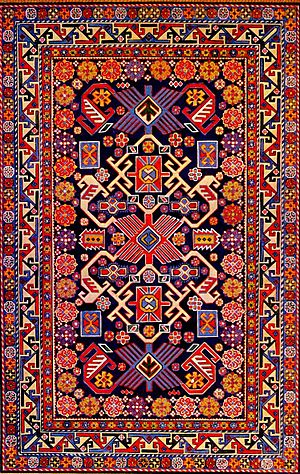Azerbaijani carpet facts for kids
Azerbaijani carpets (Azerbaijani: Azərbaycan xalçaları) are special carpets made in Azerbaijan. This country is a very old place where people have been making carpets for a long time. An Azerbaijani carpet is a traditional textile made by hand. These carpets come in many sizes. They have a tight weave and can feel smooth or a bit rough. Their patterns are unique to different carpet-making regions in Azerbaijan. For a long time, people in Azerbaijan used carpets to cover floors. They also used them to decorate walls, sofas, chairs, beds, and tables.
Making carpets is a family tradition. It is passed down through generations, often by showing and practicing. Making carpets and rugs has mostly been a job for women. In the past, every young girl had to learn how to weave carpets. The carpets she wove became part of her dowry when she got married. If a son got married, his mother would weave a large rug for his new home. Starting a new carpet was a special event. Finishing a rug was an even bigger celebration for the family! Long ago, finished carpets were laid outside the house. This allowed people walking by to step on them, making the knots even tighter.
For traditional carpet making, men would remove wool from sheep in spring and autumn. Women would collect natural dyes and spin and dye the yarn in spring, summer, and autumn. Azerbaijani carpets are grouped into four main regions: Quba-Shirvan, Ganja-Kazakh, Karabakh, and Baku.
In November 2010, UNESCO recognized the Azerbaijani carpet. It was named a "Masterpiece of Oral and Intangible Heritage." This means it's a very important cultural tradition.
Contents
About Azerbaijani Carpets
Azerbaijani carpets are known for their beautiful designs and strong quality. They are not just floor coverings. They are also works of art that tell stories about the culture and history of Azerbaijan. Each carpet can take a long time to make. This is because every knot is tied by hand.
How Carpets Are Made
The process of making an Azerbaijani carpet is very detailed. It starts with getting the wool. Men shear the sheep to get the wool in spring and autumn. Then, women prepare the wool. They collect plants and other natural materials to make dyes. These dyes give the yarn its rich colors. After dyeing, the yarn is spun. Then, the weaving begins on a special loom. Each carpet maker follows patterns that have been passed down for many years.
Carpet Regions and Their Styles
Azerbaijan has different regions, and each one has its own special carpet style.
- Quba-Shirvan: Carpets from these areas often have bright colors and detailed patterns. They might feature geometric shapes or designs inspired by nature.
- Ganja-Kazakh: These carpets are known for their bold, strong patterns. They often use deep, rich colors.
- Karabakh: Carpets from Karabakh are famous for their unique designs. They sometimes include images of animals or people.
- Baku: Carpets from the capital city area often have more delicate patterns. They might use softer colors.
Special Recognition
The Azerbaijani carpet is more than just a craft. It is a very important part of the country's heritage. UNESCO's recognition in 2010 helped show the world how special these carpets are. This honor helps make sure that the art of Azerbaijani carpet weaving continues for many more years.
Related pages
Images for kids
-
Namazlyg carpet from Shusha. 19th century.
-
A Karabagh carpet of the Malibayli sub-group. Malibayli village of Shusha, 1813
See also
 In Spanish: Alfombra de Azerbaiyán para niños
In Spanish: Alfombra de Azerbaiyán para niños







